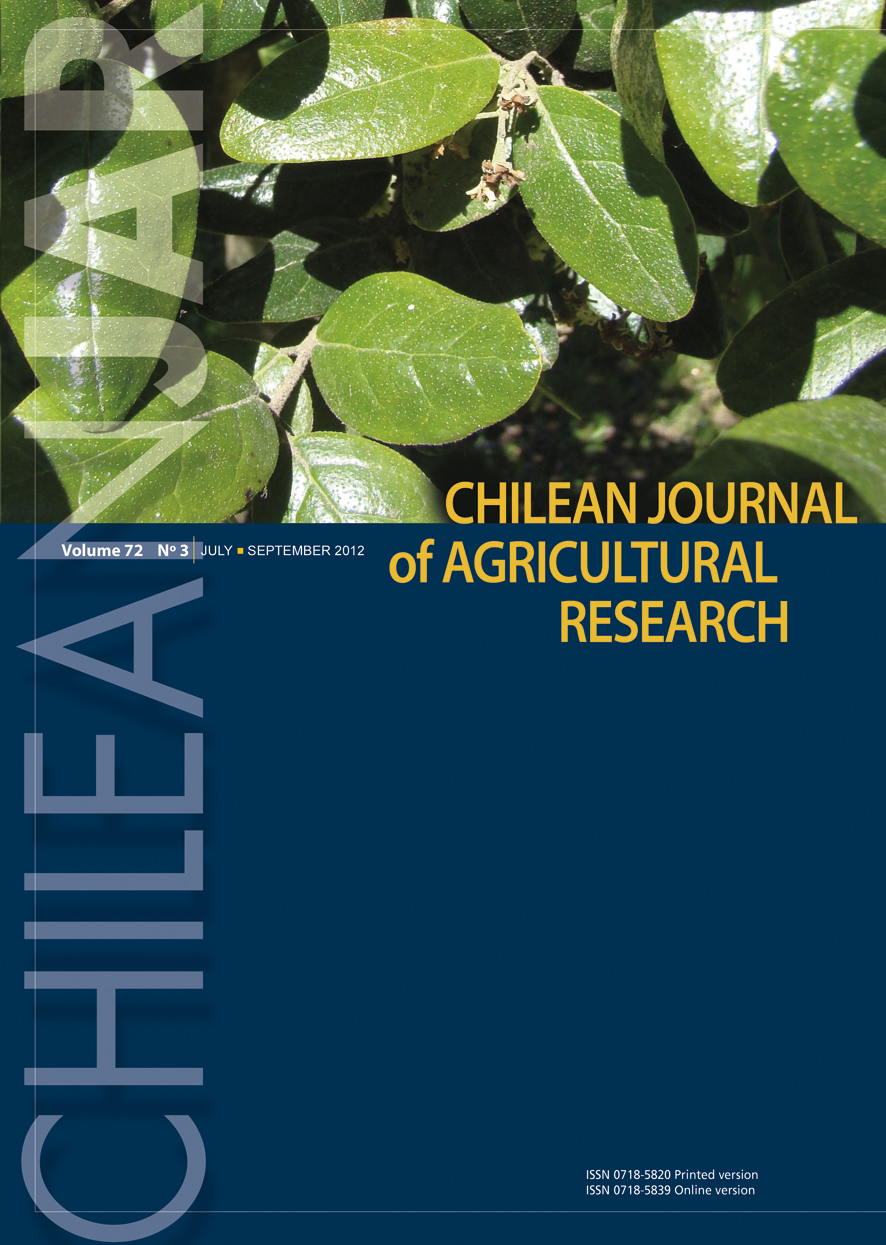
|
Chilean Journal of Agricultural Research
Instituto de Investigaciones Agropecuarias, INIA
ISSN: 0718-5820
EISSN: 0718-5820
Vol. 71, No. 1, 2011, pp. 132-139
|
 Bioline Code: cj11016
Bioline Code: cj11016
Full paper language: English
Document type: Research Article
Document available free of charge
|
|
|
Chilean Journal of Agricultural Research, Vol. 71, No. 1, 2011, pp. 132-139
| es |
Fijación Biológica de N2 en Praderas Mono y Poliespecíficas de Leguminosas en la Zona Mediterránea Húmeda de Chile.
Espinoza, Soledad; Ovalle, Carlos; del Pozo, Alejandro; Zagal, Erik & Urquiaga, Segundo
Resumen
A pesar de la gran importancia que las praderas de leguminosas tienen en los sistemas agrícolas de secano en ambientes mediterráneos, existe muy poca información sobre la fijación biológica de N2 (FBN) reportada en Chile. En este estudio se evaluó la FBN en cuatro leguminosas forrajeras anuales: trébol subterráneo (Trifolium subterraneum L.), serradela amarilla (Ornithopus compressus L.), trébol vesiculoso (T. vesiculosum L.) y trébol encarnado (T. incarnatum L.) (Experimento 1), además de siete mezclas de estas especies (Experimento 2). La FBN se midió mediante la técnica de la abundancia natural de 15N. El objetivo fue determinar la FBN en las especies de leguminosas como en las diferentes mezclas. El estudio se llevó a cabo en un suelo Andisol, de la Precordillera Andina, localizada en la zona mediterránea húmeda de Chile. En la pradera se evaluó producción de biomasa y en submuestras se analizó N total y abundancia natural de 15N. En el Experimento 1, el N derivado de la fijación fluctuó entre 43 y 147 kg N ha-1; siendo T. vesiculosum y T. subterraneum los que presentaron diferencias estadísticas (P ≤ 0,05) con respecto a las otras especies en estudio. En las mezclas de leguminosas (Experimento 2) el N derivado de la fijación fluctuó entre 97 y 214 kg N ha-1; siendo las mezclas 50-50 (T. subterraneum - O. compressus y T. subterraneum - T. vesiculosum, respectivamente) los que presentaron la mayor fijación de N por ha. El N fijado fluctuó entre 12 y 25 kg N t-1 MS, presentando diferencias significativas entre especies de leguminosas mono y poliespecíficas.
Palabras-clave
abundancia natural de 15N, praderas mediterráneas, suelo volcánico.
|
| |
| en |
Biological Fixation of N2 in Mono and Polyspecific Legume Pasture in the Humid Mediterranean Zone of Chile
Espinoza, Soledad; Ovalle, Carlos; del Pozo, Alejandro; Zagal, Erik & Urquiaga, Segundo
Abstract
Despite annual legume pasture are of great importance for dryland agricultural systems in Mediterranean environments, there are few studies of N2 biological fixation (NBF) reported in Chile. In this study the NBF of four annual legume species: subterranean clover (Trifolium subterraneum L.), yellow serradella (Ornithopus compressus L.), arrow-leaf clover (T. vesiculosum L.), and crimson clover (T. incarnatum L.) (Experiment 1), as well as seven mixtures of these species (Experiment 2) were assessed. The NBF was measured by the 15N natural abundance technique. The objective was to determine NBF in the legume species and in distinct mixtures used. The study was carried out in an Andisol of the Andean Precordillera located in the humid Mediterranean zone of Chile. Pasture was evaluated for biomass; and total N and natural abundance of 15N were analyzed in plant material samples. In Experiment 1 (monospecific legume species pasture), N derived from fixation ranged between 43 and 147 kg N ha-1 and where T. vesiculosum and T. subterraneum presented statistical differences (P ≤ 0.05) in connection with the other species. In the legume mixtures (Experiment 2), N derived by fixation varied between 97 and 214 kg N ha-1 where the 50-50 mixtures (T. subterraneum and O. compressus, or T. subterraneum and T. vesiculosum, respectively) had the highest N fixation. Fixed N ranged between 12 and 25 kg N t-1 DM, showing significant differences among mono and polyspecific legume species.
Keywords
Natural abundance of 15N, Mediterranean pastures, volcanic soil.
|
| |
© Copyright 2010 Chilean Journal of Agricultural Research.
Alternative site location: http://www.inia.cl
|
|
